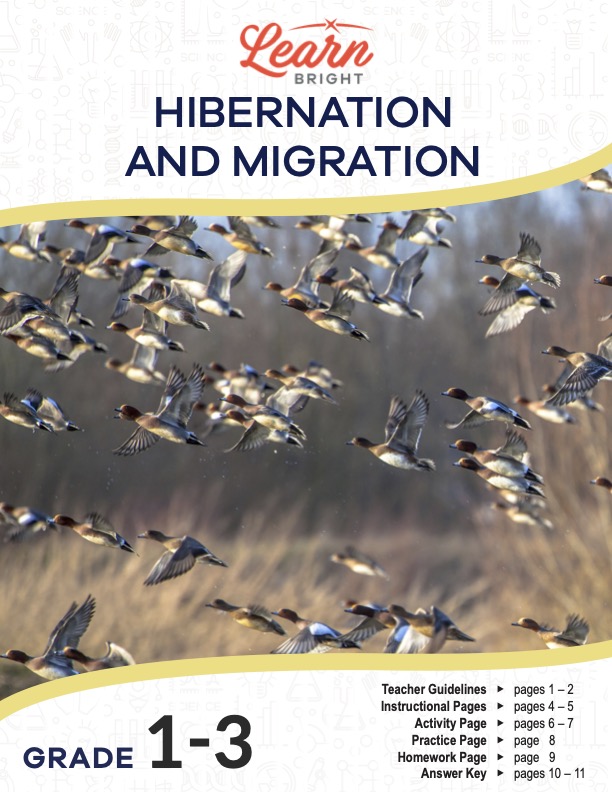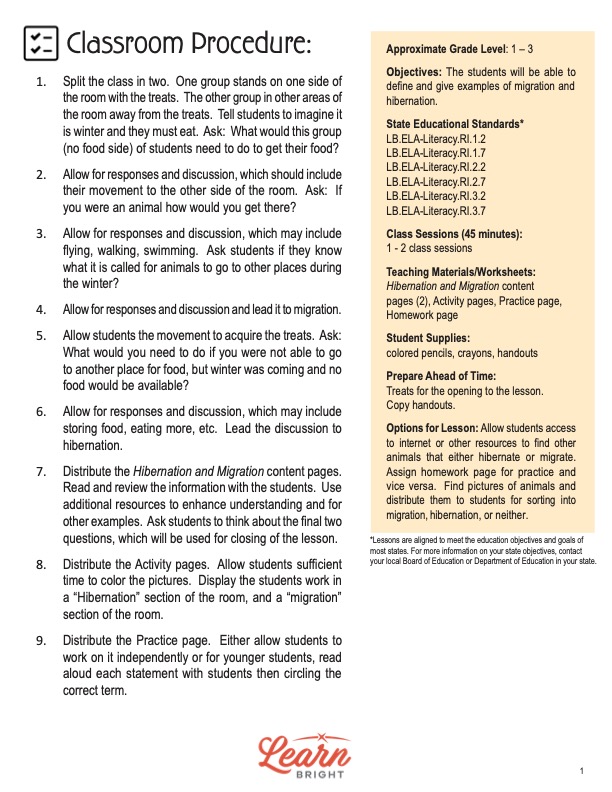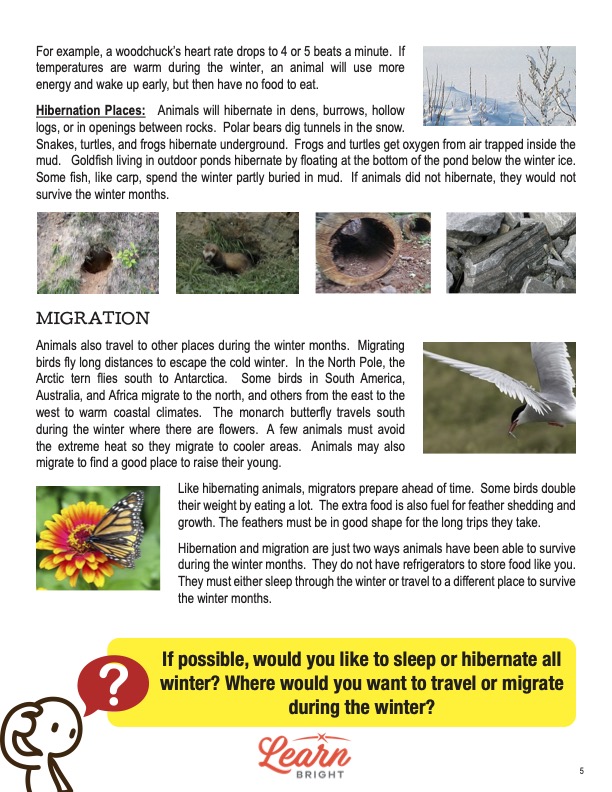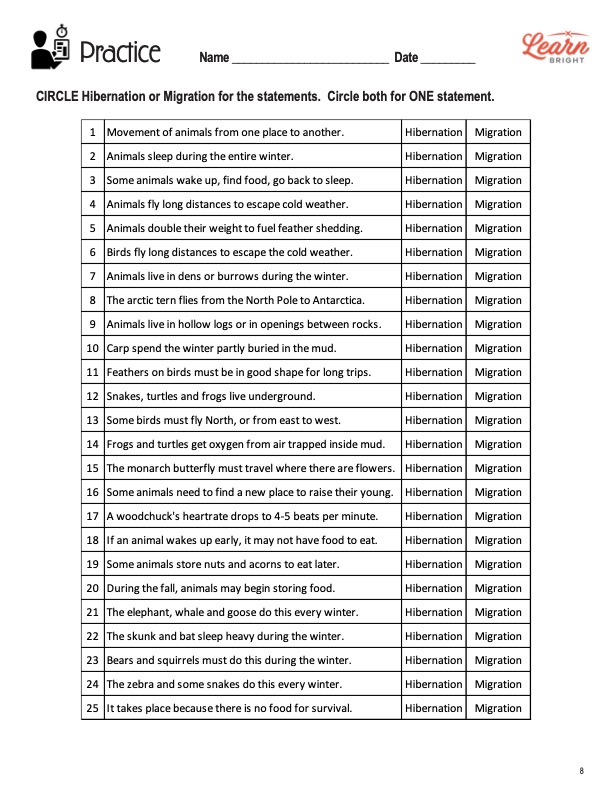Description
What our Hibernation and Migration lesson plan includes
Lesson Objectives and Overview: Hibernation and Migration explores these two interesting behaviors that some animals do during winter months. By the end of the lesson, students will be able to define the two terms and provide examples of animals that either hibernate or migrate. This lesson is for students in 1st grade, 2nd grade, and 3rd grade.
Classroom Procedure
Every lesson plan provides you with a classroom procedure page that outlines a step-by-step guide to follow. You do not have to follow the guide exactly. The guide helps you organize the lesson and details when to hand out the worksheets. It also lists information in the yellow box that you might find useful. You will find the lesson objectives, state standards, and number of class sessions the lesson should take to complete in this area. In addition, it describes the supplies you will need as well as what and how you need to prepare beforehand. For this lesson, the only other supplies you will need to provide students in addition to the worksheets are colored pencils or crayons. You will, however, need to bring in some treats for the lesson opening.
Options for Lesson
In the “Options for Lesson” section of the classroom procedure page, there are a number of suggestions for additional activities or tasks to add to the lesson if you want to. One suggestion is to allow students internet access or provide other sources they can use to discover other animals that hibernate or migrate. You could choose to assign the homework assignment as the practice worksheet and vice versa. Another option is to find pictures of animals to distribute to the class and have them sort the pictures into three groups: animals that hibernate, migrate, or do neither.
Teacher Notes
The teacher notes page provides a paragraph of extra information or guidance for the lesson. It mentions focusing on the difference between migration and hibernation and the reasons certain animals behave in these ways. It also suggests showing a video that relates to hibernating or migrating.
HIBERNATION AND MIGRATION LESSON PLAN CONTENT PAGES
During the Winter
The Hibernation and Migration lesson plan contains two content pages. It starts out by asking students if they ever think about sleeping in all day, all week, or for an entire three months. Students will learn that if their answer is yes, they would basically be doing what some animals do during the winter months in many parts of the world.
We call this behavior hibernation. When animals hibernate, they rest or remain asleep during the entire winter. The reason they do this is that food is unavailable where they live during the colder months. Students will learnt that there are different ways that students learn to hibernate.
The lesson then asks students if they have ever thought about moving to another place and living there during the winter. If they have, it means they would be doing what other animals do during wintertime. This behavior is called migration, which is not the same thing as hibernation.
Migration is the movement of animals from one place to another. One reason certain animals migrate is actually the same reason other animals hibernate. There is no food where they live, so they have to find it elsewhere. These animals travel to other places to live during the winter. The lesson compares it to a vacation, except the animals migrate to survive, not to have fun.
Hibernation
Students will discover that there are two types of hibernating animals: heavy sleepers and light sleepers. Heavy sleepers, such as the woodchuck, skunk, and bat, do not wake up all throughout the winter months. They instead sleep the entire season. Light sleepers, on the other hand, wake up to find food. Then they return home and go back to sleep. Examples include raccoons, opossums, and bears.
All these animals need to prepare for hibernation. During the fall, they get ready to hibernate either by eating extra food or by storing food. Some animals, for instance, store acorns and nuts to eat later. In addition, their bodies change to prepare for the coming cold weather. Their heartbeats slow and their body temperature decreases. For instance, a woodchuck’s heart rate drops to four or five beats a minute!
If the temperatures warm up during the winter instead of remaining cold, an animal may use more energy and wake up early. The problem, however, is that there is still no food to eat. (This might be a tricky concept for students to understand, so you may want to spend a little more time explaining it.)
Students will learn that the places in which animals can hibernate vary. They might use dens, burrows, hollow logs, or openings between rocks. Polar bears actually dig tunnels in the snow. Snakes, turtles, and frogs likewise go underground. They get oxygen from the air trapped inside the mud. Goldfish in outdoor ponds float at the bottom below the winter ice. Carp, another kind of fish, spend the winter partially buried in mud.
Migration
Next, students will learn more about migration. Animals migrate by traveling to other places for the winter months. Birds that migrate fly long distances to escape the cold winter. In the North Pole, the Arctic tern flies south all the way to Antarctica! Some birds in South America, Australia, and Africa travel north. Other birds from the east fly westward to the warm coastal climates.
Monarch butterflies also migrate by traveling south where there are flowers. And while many animals need to escape the cold, some animals must avoid extreme heat, so they migrate to cooler areas. Then there are animals that migrate to find a good place to raise their young.
Like hibernating animals, migrators need to prepare ahead of time. Some birds double their weight by eating a lot before taking the trip elsewhere. The extra food all provides fuel for feather shedding and growth. Their feathers have to be in good shape for their long trips.
Key Terms
Here is a list of the vocabulary words students will learn in this lesson plan:
- Hibernation: a behavior of animals that rest or remain asleep during the entire winter
- Migration: the movement of animals from place to another
- Heavy sleeper: animals that do not wake up throughout the winter when they hibernate
- Light sleeper: animals that wake up and find food occasionally throughout the winter when they hibernate
HIBERNATION AND MIGRATION LESSON PLAN WORKSHEETS
The Hibernation and Migration lesson plan includes three worksheets. Each one will help reinforce students’ grasp of the lesson material. You can refer to the classroom procedure guidelines, which describe when to hand out the worksheets to the class.
COLORING PAGES ACTIVITY
The activity worksheet contains two pages, both of which show a number of animals. The first page shows five pictures of hibernating animals, and the second page shows six pictures of migrating animals. Students will color the 11 animals for the activity. You are welcome to get creative with additional tasks for students to do. For instance, you could have students cut out the pictures and sort them into lists of animals that hibernate and those that migrate. Or you could describe the animal without naming it and have students guess the animal. Once they guess correctly, they can color that animal.
HIBERNATION AND MIGRATION PRACTICE WORKSHEET
For the practice worksheet, students will read through 25 statements. They have to decide if the statement represents hibernation or migration. The columns on the right provide the two options. Students will circle whichever option is correct. One statement will describe both hibernation and migration.
DOES THE ANIMAL . . . HOMEWORK WORKSHEETS
The homework assignment requires students to decide whether nine animals hibernate or migrate. They will write the correct term in the spaces beneath each picture.
Worksheet Answer Keys
The final two pages of the PDF are answer keys for the practice and homework worksheets. Both answer keys provide the answers in red. If you choose to administer the lesson pages to your students via PDF, you will need to save a new file that omits these pages. Otherwise, you can simply print out the applicable pages and keep these as reference for yourself when grading assignments.









